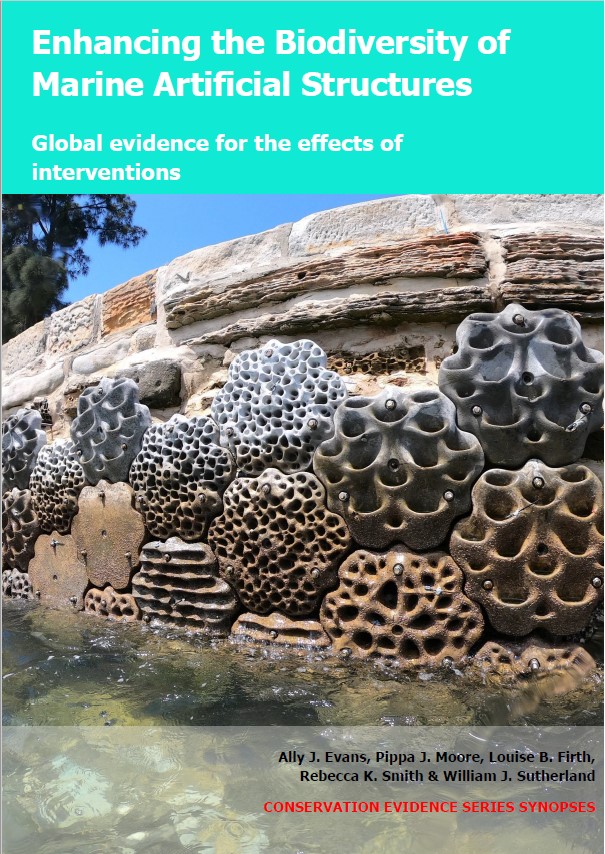Background information and definitions
Definition: ‘Cease or alter maintenance activities’ includes actions taken to avoid or reduce the disturbance, damage or removal of native organisms from structures, with the aim of enhancing their biodiversity.
Intertidal rocky habitats experience intermittent disturbance from storms, sedimentation, pollution and other human activities, which lead to fluctuations in biodiversity (e.g. Vaselli et al. 2008). These pressures are often more pronounced and frequent on artificial structures, especially those built in urban areas with high human activity and poor water quality, and/or in areas of high wave energy (Airoldi & Bulleri 2011; Moschella et al. 2005). Artificial structures are also often subject to disturbance from maintenance activities carried out to ensure they remain fit-for-purpose, safe, and aesthetically acceptable. Maintenance can include repairing or reinforcing points of weakness such as eroded cracks or holes, moving or replacing dislodged components, or cleaning regimes using physical or chemical methods. Such activities can further disturb, damage or remove biodiversity from structure surfaces (Airoldi & Bulleri 2011; Sherrard et al. 2016), reduce the availability of microhabitats for organisms to shelter in (Moreira et al. 2007), and leave bare space available to opportunistic non-native or other nuisance species (Bulleri & Airoldi 2005).
Although some maintenance is likely to be essential, there may be opportunities to cease or alter activities that disturb, damage or remove native organisms from intertidal artificial structures, to maintain or enhance their biodiversity. Altering activities could include using lower-impact methods, reducing the frequency or adjusting the timing of maintenance to avoid disturbance, damage, removal or the creation of bare space on surfaces when non-native or problematic species are more likely to occupy it (Airoldi & Bulleri 2011; Bulleri & Airoldi 2005; Gallagher et al. 2016). It could also include allowing natural weathering of structure surfaces to occur, creating rough texture and microhabitat spaces (Moreira et al. 2007).
Studies of the effects of real or simulated maintenance activities to illustrate their impact compared with no or altered maintenance, where it is not clear that ceasing/altering maintenance would be a feasible conservation action, are not included but are informative (e.g. Airoldi & Bulleri 2011; Bulleri & Airoldi 2005; Moreira et al. 2007). Studies that investigate cleaning activities to control or remove non-native or nuisance species are similarly not included where these actions are indiscriminate, simultaneously removing all biodiversity (e.g. Novak et al. 2017).
See also: Control or remove non-native or nuisance species on intertidal artificial structures; Manage or restrict harvesting of species on intertidal artificial structures.
Airoldi L. & Bulleri F. (2011) Anthropogenic disturbance can determine the magnitude of opportunistic species responses on marine urban infrastructures. PLoS ONE, 6, e22985.
Bulleri F. & Airoldi L. (2005) Artificial marine structures facilitate the spread of a non-indigenous green alga, Codium fragile ssp. tomentosoides, in the north Adriatic Sea. Journal of Applied Ecology, 42, 1063–1072.
Gallagher M.C., Culloty S., McAllen R. & O’Riordan R. (2016) Room for one more? Coexistence of native and non-indigenous barnacle species. Biological Invasions, 18, 3033–3046.
Moreira J., Chapman M.G. & Underwood A.J. (2007) Maintenance of chitons on seawalls using crevices on sandstone blocks as habitat in Sydney Harbour, Australia. Journal of Experimental Marine Biology and Ecology, 347, 134–143.
Moschella P.S., Abbiati M., Åberg P., Airoldi L., Anderson J.M., Bacchiocchi F., Bulleri F., Dinesen G.E., Frost M., Gacia E., Granhag L., Jonsson P.R., Satta M.P., Sundelöf A., Thompson R.C. & Hawkins S.J. (2005) Low-crested coastal defence structures as artificial habitats for marine life: using ecological criteria in design. Coastal Engineering, 52, 1053–1071.
Novak L., López-Legentil S., Sieradzki E. & Shenkar N. (2017) Rapid establishment of the non-indigenous ascidian Styela plicata and its associated bacteria in marinas and fishing harbors along the Mediterranean coast of Israel. Mediterranean Marine Science, 18, 324–331.
Sherrard T.R.W., Hawkins S.J., Barfield P., Kitou M., Bray S. & Osborne P.E. (2016) Hidden biodiversity in cryptic habitats provided by porous coastal defence structures. Coastal Engineering, 118, 12–20.
Vaselli S., Bertocci I., Maggi E. & Benedetti-Cecchi L. (2008) Effects of mean intensity and temporal variance of sediment scouring events on assemblages of rocky shores. Marine Ecology Progress Series, 364, 57–66.






)_2023.JPG)














